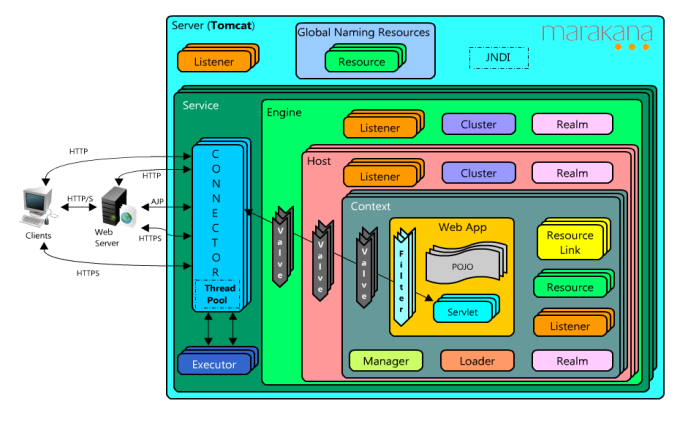1. Remote
Method Invocation (RMI)
2. Hessian
3. Burlap
4. HTTP invoker
5. EJB
6. JAX-RPC
7. JMX
zz from http://marakana.com/forums/tomcat/general/106.html

Valve and Filter:
"Valve" is Tomcat
specific notion, and they get applied at a higher level than anything in a specific webapp. Also, they work only in Tomcat.
"Filter" is a Servlet Specification notion and should work in any compliant servlet container. They get applied at a lower level than all of Tomcat's
Valves.
However, consider also the division between your application and the application
server. Think whether the feature you're planning is part of your application, or is it rather a generic feature of the application server, which could have uses in other applications as well. This would be the correct criteria to decide between Valve and Filter.
Order for filter: The order in which they are
defined matters. The container will execute the filters in the order
in which they are defined.
Use one single table "blank_fields" for both A and B. "blank_fields" has fields: 'ref_id', 'blank_field', 'type'. 'type' is used to identify which entity the record belongs to. Use 'type' + 'ref_id' to specify the collection of elements for one entity.
@Entity
@Table(name = "table_a")
public class A {
private Set<BlankField> blankFields = new HashSet<BlankField>();
@CollectionOfElements
@Fetch(FetchMode.SUBSELECT)
@Enumerated(EnumType.ORDINAL)
@JoinTable(name = "blank_fields", joinColumns = { @JoinColumn(name = "ref_id") })
@Cascade(value = org.hibernate.annotations.CascadeType.DELETE_ORPHAN)
@Column(name = "blank_field", nullable = false)
@SQLInsert(sql = "INSERT INTO blank_fields(ref_id, blank_field, type) VALUES(?,?,0)")
@Where(clause = "type=0")
public Set<BlankField> getBlankFields() { // BlankField is an enum
return blankFields;
}
@SuppressWarnings("unused")
private void setBlankFields(Set<BlankField> blankFields) {
this.blankFields = blankFields;
}
} // End B
@Entity
@Table(name = "table_b")
public class B {
private Set<BlankField> blankFields = new HashSet<BlankField>();
@CollectionOfElements
@Fetch(FetchMode.SUBSELECT)
@Enumerated(EnumType.ORDINAL)
@JoinTable(name = "blank_fields", joinColumns = { @JoinColumn(name = "ref_id") })
@Cascade(value = org.hibernate.annotations.CascadeType.DELETE_ORPHAN)
@Column(name = "blank_field", nullable = false)
@SQLInsert(sql = "INSERT INTO blank_fields(ref_id, blank_field, type) VALUES(?,?,1)") // used for insert
@Where(clause = "type=1") // used for query, if not @CollectionOfElements, such as @OneToMany, use @WhereJoinTable instead
public Set<BlankField> getBlankFields() {
return blankFields;
}
@SuppressWarnings("unused")
private void setBlankFields(Set<BlankField> blankFields) {
this.blankFields = blankFields;
}
}
當然還有其他的方式來實現上面的需求��,上面采用的單表來記錄不同實體的associations(這兒是CollectionOfElements,并且返回的是Set<Enum>,不是Set<Embeddable>),然后用'type'來區分不同的實體,這樣做的好處是:數據庫冗余少����,易于擴展�����,對于新的實體,只需加一個type值,而不需更改數據庫表結構�����。另外一種采用單表的方式是為每個實體增加新的字段�����,如"blank_fields": 'a_id', 'b_id', 'blank_field', a_id reference table_a (id), b_id reference table_b (id). 這樣在映射的時候更簡單����,
對于A�����,映射為
@JoinTable(name = "blank_fields", joinColumns = { @JoinColumn(name = "a_id") })
對于B����,映射為
@JoinTable(name = "blank_fields", joinColumns = { @JoinColumn(name = "b_id") })
這樣作的缺點是:帶來了數據庫冗余��,對于blank_fields來講�����,任一條記錄,a_id和b_id中只有一個不為null。當多個實體共用這個表時,用上面的方法更合理,如果共用實體不多時,這種方法更方便�����。